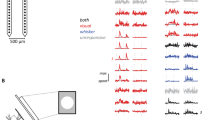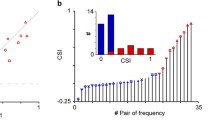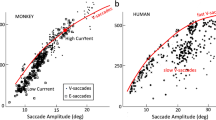Abstract
The superior colliculus (SC) plays an important role in integrating visual, auditory and somatosensory information, and in guiding the orientation of the eyes, ears and head. Previously we have shown that cats with unilateral SC lesions showed a preferential loss of multisensory orientation behaviors for stimuli contralateral to the lesion. Surprisingly, this behavioral loss was seen even under circumstances where the SC lesion was far from complete. To assess the physiological changes induced by these lesions, we employed single unit electrophysiological methods to record from individual neurons in both the intact and damaged SC following behavioral testing in two animals. In the damaged SC of these animals, multisensory neurons were preferentially reduced in incidence, comprising less than 25% of the sensory-responsive population (as compared with 49% on the control side). In those multisensory neurons that remained following the lesion, receptive fields were nearly twofold larger, and less than 25% showed normal patterns of multisensory integration, with those that did being found in areas outside of the lesion. These results strongly suggest that the multisensory behavioral deficits seen following SC lesions are the combined result of a loss of multisensory neurons and a loss of multisensory integration in those neurons that remain.









Similar content being viewed by others
References
Behan M, Kime NM (1996) Intrinsic circuitry in the deep layers of the cat superior colliculus. Vis Neurosci 13:1031–1042
Behan M, Appell PP, Graper MJ (1988) Ultrastructural study of large efferent neurons in the superior colliculus of the cat after retrograde labeling with horseradish peroxidase. J Comp Neurol 270:171–184
Benson CG, Gross JS, Suneja SK, Potashner SJ (1997) Synaptophysin immunoreactivity in the cochlear nucleus after unilateral cochlear or ossicular removal. Synapse 25:243–257
Berlucchi G, Sprague JM, Levy J, DiBerardino AC (1972) Pretectum and superior colliculus in visually guided behavior and in flux and form discrimination in the cat. J Comp Physiol Psychol 78:123–172
Berson DM, Graybiel AM, Bowen WD, Thompson LA (1991) Evidence for intrinsic expression of enkephalin-like immunoreactivity and opioid binding sites in cat superior colliculus. Neuroscience 43:513–529
Bourne JA, Rosa MG (2003) Laminar expression of neurofilament protein in the superior colliculus of the marmoset monkey (Callithrix jacchus). Brain Res 973:142–145
Buonomano DV, Merzenich MM (1998) Cortical plasticity: from synapses to maps. Annu Rev Neurosci 21:149–86
Burnett LR, Stein BE, Chaponis D, Wallace MT (2004) Superior colliculus lesions preferentially disrupt multisensory orientation. Neuroscience 124:535–547
Cork RJ, Baber SZ, Mize RR (1998) Calbindin d28-k and parvalbumin-immunoreactive neurons form complementary sublaminae in the rat superior colliculus. J Comp Neurol 394:205–217
de Leon M, Covenas R, Narvaez JA, Aguirre JA, Gonzalez-Baron S (1994) Distribution of calbindin D-28k-immunoreactivity in the cat brainstem. Arch Ital Biol 132:229–241
Eysel UT, Schweigart G (1999) Increased receptive field size in the surround of chronic lesions in the adult cat visual cortex. Cereb Cortex 9:101–109
Eysel UT, Schweigart G, Mittmann T, Eyding D, Qu Y, Vandesande F, Orban G, Arckens L (1999) Reorganization in the visual cortex after retinal and cortical damage. Restor Neurol Neurosci 15:153–164
Freedman EG, Stanford TR, Sparks DL (1996) Combined eye–head gaze shifts produced by electrical stimulation of the superior colliculus in rhesus monkeys. J Neurophysiol 76:927–952
Hanes DP, Wurtz RH (2001) Interaction of the frontal eye field and superior colliculus for saccade generation. J Neurophysiol 85:804–815
Harris LR (1980) The superior colliculus and movements of the head and eyes in cats. J Physiol (Lond) 300:367–391
Henkel CK, Fuentes-Santamaria V, Alvarado JC, Brunso-Bechtold JK (2003) Quantitative measurement of afferent layers in the ferret inferior colliculus: DNLL projections to sublayers. Hear Res 177:32–42
Hikosaka O, Wurtz RH (1983) Effects on eye movements of a GABA agonist and antagonist injected into monkey superior colliculus. Brain Res 272:368–372
Huang L, Pallas SL (2001) NMDA antagonists in the superior colliculus prevent developmental plasticity but not visual transmission or map compression. J Neurophysiol 86:1179–1194
Huerta MF, Harting JK (1984) The mammalian superior colliculus: studies of its morphology and connections. In: Vanegas H (ed) Comparative neurology of the optic tectum, Plenum Press, New York, pp 687–773
Ingham NJ, Thornton SK, McCrossan D, Withington DJ (1998) Neurotransmitter involvement in development and maintenance of the auditory space map in the guinea pig superior colliculus. J Neurophysiol 80:2941–2953
Jeon CJ, Hartman MK, Mize RR (1997) Glutamate-like immunoreactivity in the cat superior colliculus and visual cortex: further evidence that glutamate is the neurotransmitter of the corticocollicular pathway. Vis Neurosci 14:27–37
Jiang W, Wallace MT, Jiang H, Vaughan JW, Stein BE (2001) Two cortical areas mediate multisensory integration in superior colliculus neurons. J Neurophysiol 85:506–522
Jiang W, Jiang H, Stein BE (2002) Two corticotectal areas facilitate multisensory orientation behavior. J Cogn Neurosci 14:1240–1255
Kadunce DC, Vaughan JW, Wallace MT, Benedek G, Stein BE (1997) Mechanisms of within- and cross-modality suppression in the superior colliculus. J Neurophysiol 78:2834–2847
Kadunce DC, Vaughan JW, Wallace MT, Stein BE (2001) The influence of visual and auditory receptive field organization on multisensory integration in the superior colliculus. Exp Brain Res 139:303–310
King AJ, Palmer AR (1985) Integration of visual and auditory information in bimodal neurones in the guinea-pig superior colliculus. Exp Brain Res 60:492–500
King AJ, Schnupp JW, Carlile S, Smith AL, Thompson ID (1996) The development of topographically-aligned maps of visual and auditory space in the superior colliculus. Prog Brain Res 112:335–350
King AJ, Schnupp JW, Thompson ID (1998) Signals from the superficial layers of the superior colliculus enable the development of the auditory space map in the deeper layers. J Neurosci 18:9394–9408
Lomber SG, Payne BR, Cornwell P (2001) Role of the superior colliculus in analyses of space: superficial and intermediate layer contributions to visual orienting, auditory orienting, and visuospatial discriminations during unilateral and bilateral deactivations. J Comp Neurol 441:44–57
McHaffie JG, Stein BE (1982) Eye movements evoked by electrical stimulation in the superior colliculus of rats and hamsters. Brain Res 247:243–253
McHaffie JG, Stein BE (1983) A chronic headholder minimizing facial obstructions. Brain Res Bull 10:859–860
Meredith MA, Ramoa AS (1998) Intrinsic circuitry of the superior colliculus: pharmacophysiological identification of horizontally oriented inhibitory interneurons. J Neurophysiol 79:1597–1602
Meredith MA, Stein BE (1983) Interactions among converging sensory inputs in the superior colliculus. Science 221:389–391
Meredith MA, Stein BE (1985) Descending efferents from the superior colliculus relay integrated multisensory information. Science 227:657–659
Meredith MA, Stein BE (1986a) Spatial factors determine the activity of multisensory neurons in cat superior colliculus. Brain Res 365:350–354
Meredith MA, Stein BE (1986b) Visual, auditory, and somatosensory convergence on cells in superior colliculus results in multisensory integration. J Neurophysiol 56:640–662
Meredith MA, Stein BE (1990) The visuotopic component of the multisensory map in the deep laminae of the cat superior colliculus. J Neurosci 10:3727–3742
Meredith MA, Stein BE (1996) Spatial determinants of multisensory integration in cat superior colliculus neurons. J Neurophysiol 75:1843–1857
Meredith MA, Clemo HR, Stein BE (1991) Somatopic component of the multisensory map in the deep laminae of the cat superior colliculus. J Comp Neurol 312:353–370
Middlebrooks JC, Knudsen EI (1984) A neural code for auditory space in the cat’s superior colliculus. J Neurosci 4:2621–2634
Mize RR (1992) The organization of GABAergic neurons in the mammalian superior colliculus. Prog Brain Res 90:219–248
Mize RR (1996) Neurochemical microcircuitry underlying visual and oculomotor function in the cat superior colliculus. Prog Brain Res 112:35–55
Mize RR (1999) Calbindin 28 kD and parvalbumin immunoreactive neurons receive different patterns of synaptic input in the cat superior colliculus. Brain Res 843:25–35
Mize RR, Butler GD (2000) The NMDAR1 subunit of the N-methyl-d-aspartate receptor is localized at postsynaptic sites opposite both retinal and cortical terminals in the cat superior colliculus. Vis Neurosci 17:41–53
Moschovakis AK, Karabelas AB (1985) Observations on the somatodendritic morphology and axonal trajectory of intracellularly HRP-labeled efferent neurons located in the deeper layers of the superior colliculus of the cat. J Comp Neurol 239:276–308
Munoz DP, Guitton D (1989) Fixation and orientation control by the tecto-reticulo-spinal system in the cat whose head is unrestrained. Rev Neurol (Paris) 145:567–579
Nadler JV, Cuthbertson GJ (1980) Kainic acid neurotoxicity toward hippocampal formation: dependence on specific excitatory pathways. Brain Res 195:47–56
Nitsch R, Bader S, Frotscher M (1992) Reorganization of input synapses of parvalbumin-containing neurons in the rat fascia dentata following entorhinal lesion. Neurosci Lett 135:33–36
Okada Y (1992) The distribution and function of gamma-aminobutyric acid (GABA) in the superior colliculus. Prog Brain Res 90:249–262
Perrault TJ Jr, Vaughan JW, Stein BE, Wallace MT (2003) Neuron-specific response characteristics predict the magnitude of multisensory integration. J Neurophysiol 90:4022–4026
Perrault TJ Jr, Vaughan JW, Stein BE, Wallace MT (2005) Superior colliculus neurons use distinct operational modes in the integration of multisensory stimuli. J Neurophysiol 93:2575–2586
Razak KA, Huang L, Pallas SL (2003) NMDA receptor blockade in the superior colliculus increases receptive field size without altering velocity and size tuning. J Neurophysiol 90:110–119
Sanes JN, Donoghue JP (2000) Plasticity and primary motor cortex. Annu Rev Neurosci 23:393–415
Schiller PH, Stryker M, Cynader M, Berman N (1974) Response characteristics of single cells in the monkey superior colliculus following ablation or cooling of visual cortex. J Neurophysiol 37:181–194
Schwarcz R, Hokfelt T, Fuxe K, Jonsson G, Goldstein M, Terenius L (1979) Ibotenic acid-induced neuronal degeneration: a morphological and neurochemical study. Exp Brain Res 37:199–216
Sommer MA, Wurtz RH (1998) Frontal eye field neurons orthodromically activated from the superior colliculus. J Neurophysiol 80:3331–3335
Sprague JM (1966) Interaction of cortex and superior colliculus in mediation of visually guided behavior in the cat. Science 153:1544–1547
Sprague JM (1972) The superior colliculus and pretectum in visual behavior. Invest Ophthalmol 11:473–482
Sprague JM, Meikle TH Jr (1965) The role of the superior colliculus in visually guided behavior. Exp Neurol 11:115–146
Stanford TR, Quessy S, Stein BE (2005) Evaluating the operations underlying multisensory integration in the cat superior colliculus. J Neurosci 25:6499–6508
Stein BE (1988) Superior colliculus-mediated visual behaviors in cat and the concept of two corticotectal systems. Prog Brain Res 75:37–53
Stein BE, Clamann HP (1981) Control of pinna movements and sensorimotor register in cat superior colliculus. Brain Behav Evol 19:180–192
Stein BE, Meredith MA (1993) The merging of the senses. MIT Press, Cambridge
Stein BE, Goldberg SJ, Clamann HP (1976a) The control of eye movements by the superior colliculus in the alert cat. Brain Res 118:469–474
Stein BE, Magalhaes-Castro B, Kruger L (1976b) Relationship between visual and tactile representations in cat superior colliculus. J Neurophysiol 39:401–419
Stein BE, Huneycutt WS, Meredith MA (1988) Neurons and behavior: the same rules of multisensory integration apply. Brain Res 448:355–358
Stein BE, Meredith MA, Huneycutt WS, McDade L (1989) Behavioral indices of multisensory integration: orientation to visual cues is affected by auditory stimuli. J Cogn Neurosci 1:12–24
Tao HW, Poo MM (2005) Activity-dependent matching of excitatory and inhibitory inputs during refinement of visual receptive fields. Neuron 45:829–836
Wallace MT, Stein BE (1994) Cross-modal synthesis in the midbrain depends on input from cortex. J Neurophysiol 71:429–432
Wallace MT, Stein BE (1996) Sensory organization of the superior colliculus in cat and monkey. Prog Brain Res 112:301–311
Wallace MT, Stein BE (1997) Development of multisensory neurons and multisensory integration in cat superior colliculus. J Neurosci 17:2429–2444
Wallace MT, Stein BE (2000) Onset of cross-modal synthesis in the neonatal superior colliculus is gated by the development of cortical influences. J Neurophysiol 83:3578–3582
Wallace MT, Meredith MA, Stein BE (1993) Converging influences from visual, auditory, and somatosensory cortices onto output neurons of the superior colliculus. J Neurophysiol 69:1797–1809
Wallace MT, Wilkinson LK, Stein BE (1996) Representation and integration of multiple sensory inputs in primate superior colliculus. J Neurophysiol 76:1246–1266
Wallace MT, Meredith MA, Stein BE (1998) Multisensory integration in the superior colliculus of the alert cat. J Neurophysiol 80:1006–1010
Wilkinson LK, Meredith MA, Stein BE (1996) The role of anterior ectosylvian cortex in cross-modality orientation and approach behavior. Exp Brain Res 112:1–10
Acknowledgments
We thank Nancy London for her editorial assistance. This work was supported by NIH MH63861 and NS36916.
Author information
Authors and Affiliations
Corresponding author
Rights and permissions
About this article
Cite this article
Burnett, L.R., Stein, B.E., Perrault, T.J. et al. Excitotoxic lesions of the superior colliculus preferentially impact multisensory neurons and multisensory integration. Exp Brain Res 179, 325–338 (2007). https://doi.org/10.1007/s00221-006-0789-8
Received:
Accepted:
Published:
Issue Date:
DOI: https://doi.org/10.1007/s00221-006-0789-8




